Pedagogy for Diversity: Teaching Strategies for Diverse Classrooms
VerifiedAdded on 2022/11/22
|10
|2933
|228
AI Summary
This essay analyzes diversity and inclusion within the classroom setting and the teaching strategies that the teachers are required to adopt for the effective management of the same. It discusses the needs of students with special learning abilities and the teaching strategies that teachers can adopt to offer high-quality education to them.
Contribute Materials
Your contribution can guide someone’s learning journey. Share your
documents today.
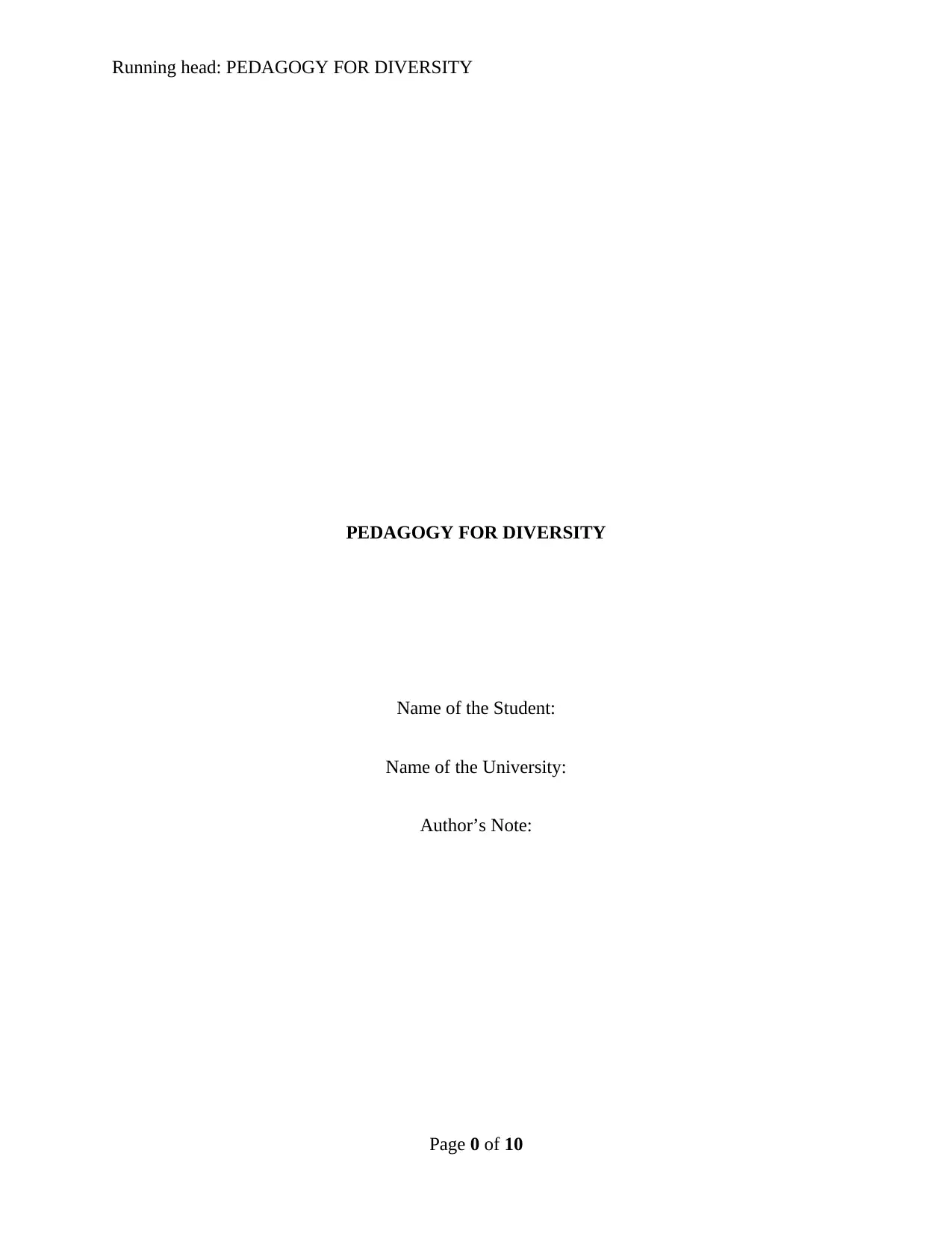
Running head: PEDAGOGY FOR DIVERSITY
PEDAGOGY FOR DIVERSITY
Name of the Student:
Name of the University:
Author’s Note:
Page 0 of 10
PEDAGOGY FOR DIVERSITY
Name of the Student:
Name of the University:
Author’s Note:
Page 0 of 10
Secure Best Marks with AI Grader
Need help grading? Try our AI Grader for instant feedback on your assignments.
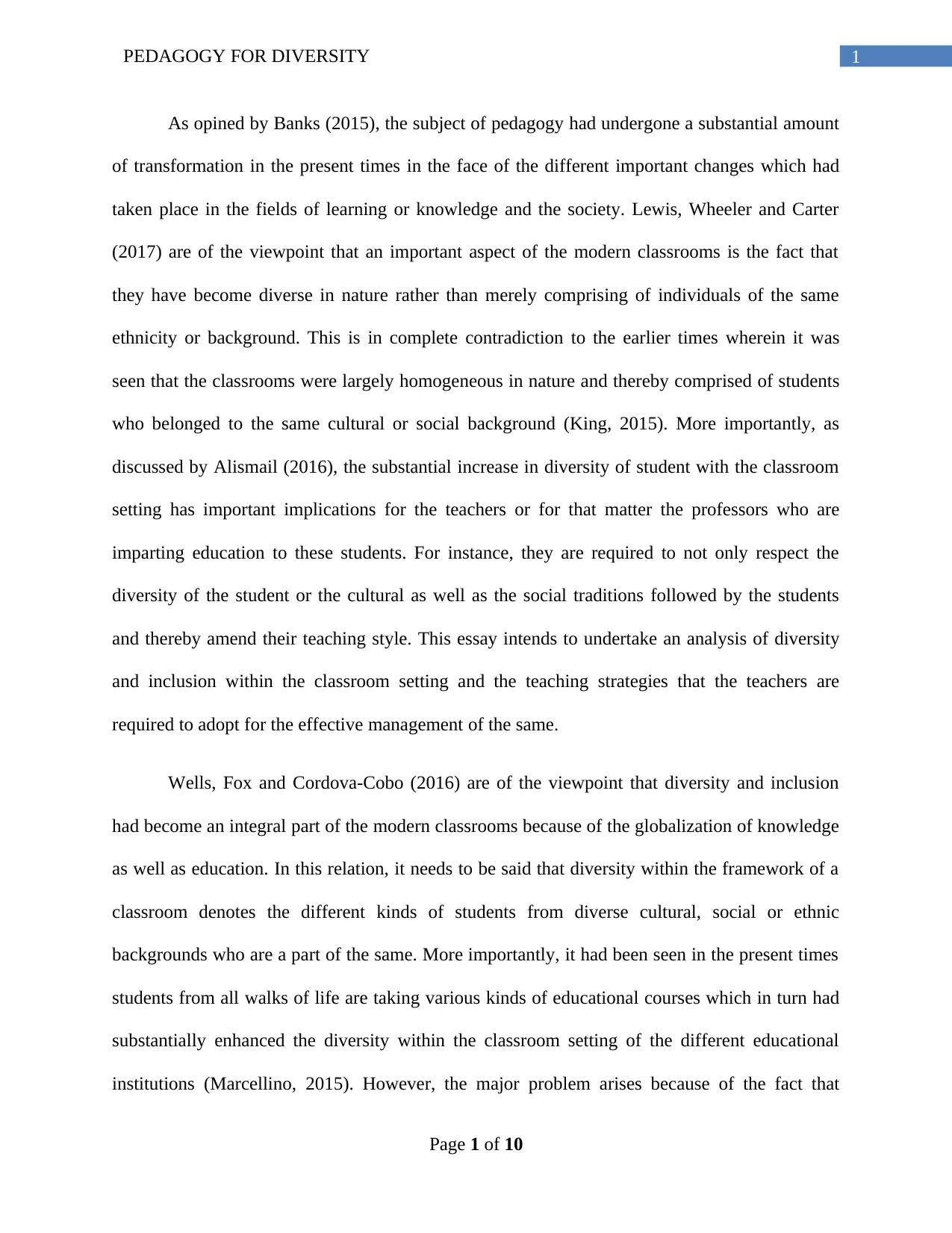
1PEDAGOGY FOR DIVERSITY
As opined by Banks (2015), the subject of pedagogy had undergone a substantial amount
of transformation in the present times in the face of the different important changes which had
taken place in the fields of learning or knowledge and the society. Lewis, Wheeler and Carter
(2017) are of the viewpoint that an important aspect of the modern classrooms is the fact that
they have become diverse in nature rather than merely comprising of individuals of the same
ethnicity or background. This is in complete contradiction to the earlier times wherein it was
seen that the classrooms were largely homogeneous in nature and thereby comprised of students
who belonged to the same cultural or social background (King, 2015). More importantly, as
discussed by Alismail (2016), the substantial increase in diversity of student with the classroom
setting has important implications for the teachers or for that matter the professors who are
imparting education to these students. For instance, they are required to not only respect the
diversity of the student or the cultural as well as the social traditions followed by the students
and thereby amend their teaching style. This essay intends to undertake an analysis of diversity
and inclusion within the classroom setting and the teaching strategies that the teachers are
required to adopt for the effective management of the same.
Wells, Fox and Cordova-Cobo (2016) are of the viewpoint that diversity and inclusion
had become an integral part of the modern classrooms because of the globalization of knowledge
as well as education. In this relation, it needs to be said that diversity within the framework of a
classroom denotes the different kinds of students from diverse cultural, social or ethnic
backgrounds who are a part of the same. More importantly, it had been seen in the present times
students from all walks of life are taking various kinds of educational courses which in turn had
substantially enhanced the diversity within the classroom setting of the different educational
institutions (Marcellino, 2015). However, the major problem arises because of the fact that
Page 1 of 10
As opined by Banks (2015), the subject of pedagogy had undergone a substantial amount
of transformation in the present times in the face of the different important changes which had
taken place in the fields of learning or knowledge and the society. Lewis, Wheeler and Carter
(2017) are of the viewpoint that an important aspect of the modern classrooms is the fact that
they have become diverse in nature rather than merely comprising of individuals of the same
ethnicity or background. This is in complete contradiction to the earlier times wherein it was
seen that the classrooms were largely homogeneous in nature and thereby comprised of students
who belonged to the same cultural or social background (King, 2015). More importantly, as
discussed by Alismail (2016), the substantial increase in diversity of student with the classroom
setting has important implications for the teachers or for that matter the professors who are
imparting education to these students. For instance, they are required to not only respect the
diversity of the student or the cultural as well as the social traditions followed by the students
and thereby amend their teaching style. This essay intends to undertake an analysis of diversity
and inclusion within the classroom setting and the teaching strategies that the teachers are
required to adopt for the effective management of the same.
Wells, Fox and Cordova-Cobo (2016) are of the viewpoint that diversity and inclusion
had become an integral part of the modern classrooms because of the globalization of knowledge
as well as education. In this relation, it needs to be said that diversity within the framework of a
classroom denotes the different kinds of students from diverse cultural, social or ethnic
backgrounds who are a part of the same. More importantly, it had been seen in the present times
students from all walks of life are taking various kinds of educational courses which in turn had
substantially enhanced the diversity within the classroom setting of the different educational
institutions (Marcellino, 2015). However, the major problem arises because of the fact that
Page 1 of 10
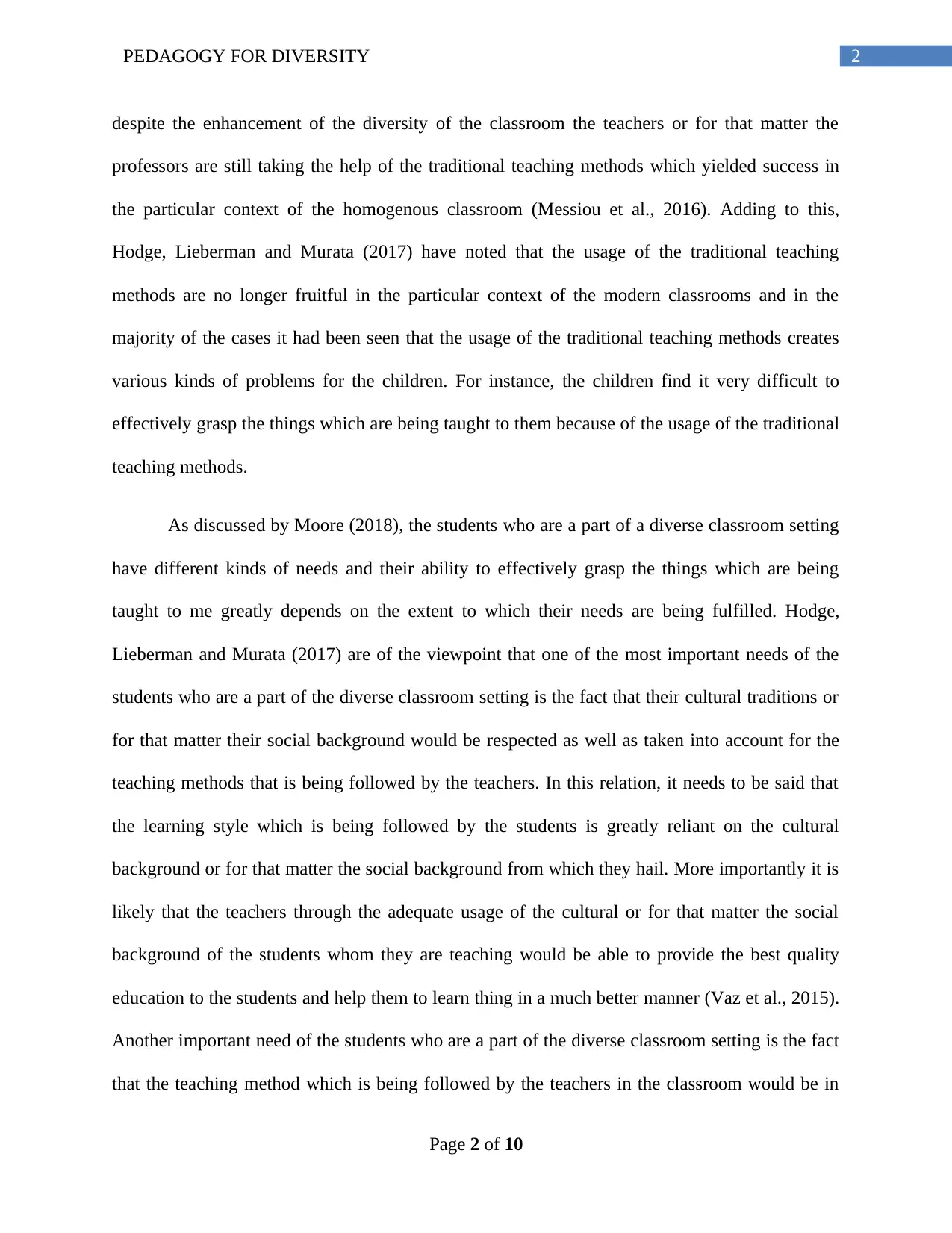
2PEDAGOGY FOR DIVERSITY
despite the enhancement of the diversity of the classroom the teachers or for that matter the
professors are still taking the help of the traditional teaching methods which yielded success in
the particular context of the homogenous classroom (Messiou et al., 2016). Adding to this,
Hodge, Lieberman and Murata (2017) have noted that the usage of the traditional teaching
methods are no longer fruitful in the particular context of the modern classrooms and in the
majority of the cases it had been seen that the usage of the traditional teaching methods creates
various kinds of problems for the children. For instance, the children find it very difficult to
effectively grasp the things which are being taught to them because of the usage of the traditional
teaching methods.
As discussed by Moore (2018), the students who are a part of a diverse classroom setting
have different kinds of needs and their ability to effectively grasp the things which are being
taught to me greatly depends on the extent to which their needs are being fulfilled. Hodge,
Lieberman and Murata (2017) are of the viewpoint that one of the most important needs of the
students who are a part of the diverse classroom setting is the fact that their cultural traditions or
for that matter their social background would be respected as well as taken into account for the
teaching methods that is being followed by the teachers. In this relation, it needs to be said that
the learning style which is being followed by the students is greatly reliant on the cultural
background or for that matter the social background from which they hail. More importantly it is
likely that the teachers through the adequate usage of the cultural or for that matter the social
background of the students whom they are teaching would be able to provide the best quality
education to the students and help them to learn thing in a much better manner (Vaz et al., 2015).
Another important need of the students who are a part of the diverse classroom setting is the fact
that the teaching method which is being followed by the teachers in the classroom would be in
Page 2 of 10
despite the enhancement of the diversity of the classroom the teachers or for that matter the
professors are still taking the help of the traditional teaching methods which yielded success in
the particular context of the homogenous classroom (Messiou et al., 2016). Adding to this,
Hodge, Lieberman and Murata (2017) have noted that the usage of the traditional teaching
methods are no longer fruitful in the particular context of the modern classrooms and in the
majority of the cases it had been seen that the usage of the traditional teaching methods creates
various kinds of problems for the children. For instance, the children find it very difficult to
effectively grasp the things which are being taught to them because of the usage of the traditional
teaching methods.
As discussed by Moore (2018), the students who are a part of a diverse classroom setting
have different kinds of needs and their ability to effectively grasp the things which are being
taught to me greatly depends on the extent to which their needs are being fulfilled. Hodge,
Lieberman and Murata (2017) are of the viewpoint that one of the most important needs of the
students who are a part of the diverse classroom setting is the fact that their cultural traditions or
for that matter their social background would be respected as well as taken into account for the
teaching methods that is being followed by the teachers. In this relation, it needs to be said that
the learning style which is being followed by the students is greatly reliant on the cultural
background or for that matter the social background from which they hail. More importantly it is
likely that the teachers through the adequate usage of the cultural or for that matter the social
background of the students whom they are teaching would be able to provide the best quality
education to the students and help them to learn thing in a much better manner (Vaz et al., 2015).
Another important need of the students who are a part of the diverse classroom setting is the fact
that the teaching method which is being followed by the teachers in the classroom would be in
Page 2 of 10
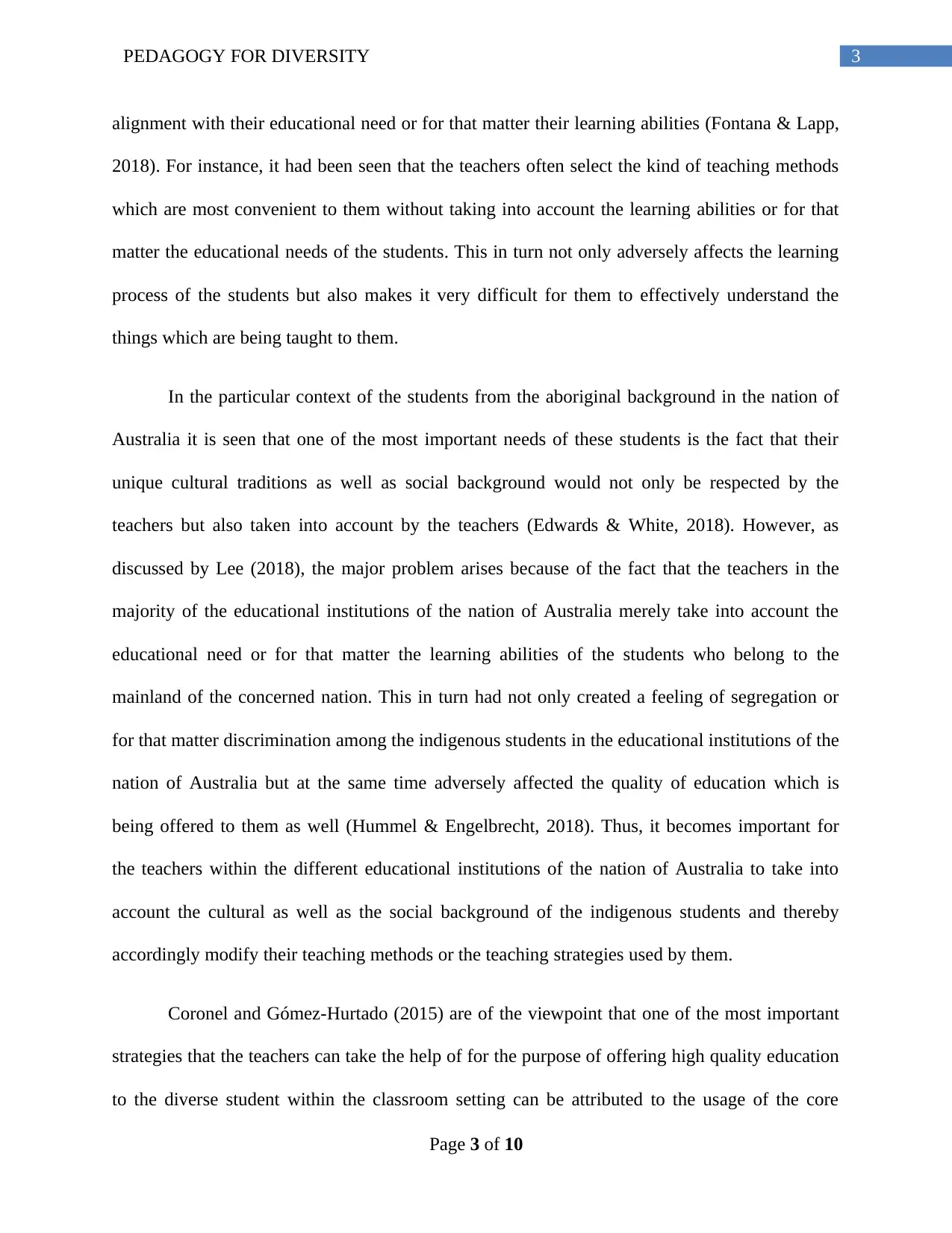
3PEDAGOGY FOR DIVERSITY
alignment with their educational need or for that matter their learning abilities (Fontana & Lapp,
2018). For instance, it had been seen that the teachers often select the kind of teaching methods
which are most convenient to them without taking into account the learning abilities or for that
matter the educational needs of the students. This in turn not only adversely affects the learning
process of the students but also makes it very difficult for them to effectively understand the
things which are being taught to them.
In the particular context of the students from the aboriginal background in the nation of
Australia it is seen that one of the most important needs of these students is the fact that their
unique cultural traditions as well as social background would not only be respected by the
teachers but also taken into account by the teachers (Edwards & White, 2018). However, as
discussed by Lee (2018), the major problem arises because of the fact that the teachers in the
majority of the educational institutions of the nation of Australia merely take into account the
educational need or for that matter the learning abilities of the students who belong to the
mainland of the concerned nation. This in turn had not only created a feeling of segregation or
for that matter discrimination among the indigenous students in the educational institutions of the
nation of Australia but at the same time adversely affected the quality of education which is
being offered to them as well (Hummel & Engelbrecht, 2018). Thus, it becomes important for
the teachers within the different educational institutions of the nation of Australia to take into
account the cultural as well as the social background of the indigenous students and thereby
accordingly modify their teaching methods or the teaching strategies used by them.
Coronel and Gómez-Hurtado (2015) are of the viewpoint that one of the most important
strategies that the teachers can take the help of for the purpose of offering high quality education
to the diverse student within the classroom setting can be attributed to the usage of the core
Page 3 of 10
alignment with their educational need or for that matter their learning abilities (Fontana & Lapp,
2018). For instance, it had been seen that the teachers often select the kind of teaching methods
which are most convenient to them without taking into account the learning abilities or for that
matter the educational needs of the students. This in turn not only adversely affects the learning
process of the students but also makes it very difficult for them to effectively understand the
things which are being taught to them.
In the particular context of the students from the aboriginal background in the nation of
Australia it is seen that one of the most important needs of these students is the fact that their
unique cultural traditions as well as social background would not only be respected by the
teachers but also taken into account by the teachers (Edwards & White, 2018). However, as
discussed by Lee (2018), the major problem arises because of the fact that the teachers in the
majority of the educational institutions of the nation of Australia merely take into account the
educational need or for that matter the learning abilities of the students who belong to the
mainland of the concerned nation. This in turn had not only created a feeling of segregation or
for that matter discrimination among the indigenous students in the educational institutions of the
nation of Australia but at the same time adversely affected the quality of education which is
being offered to them as well (Hummel & Engelbrecht, 2018). Thus, it becomes important for
the teachers within the different educational institutions of the nation of Australia to take into
account the cultural as well as the social background of the indigenous students and thereby
accordingly modify their teaching methods or the teaching strategies used by them.
Coronel and Gómez-Hurtado (2015) are of the viewpoint that one of the most important
strategies that the teachers can take the help of for the purpose of offering high quality education
to the diverse student within the classroom setting can be attributed to the usage of the core
Page 3 of 10
Secure Best Marks with AI Grader
Need help grading? Try our AI Grader for instant feedback on your assignments.
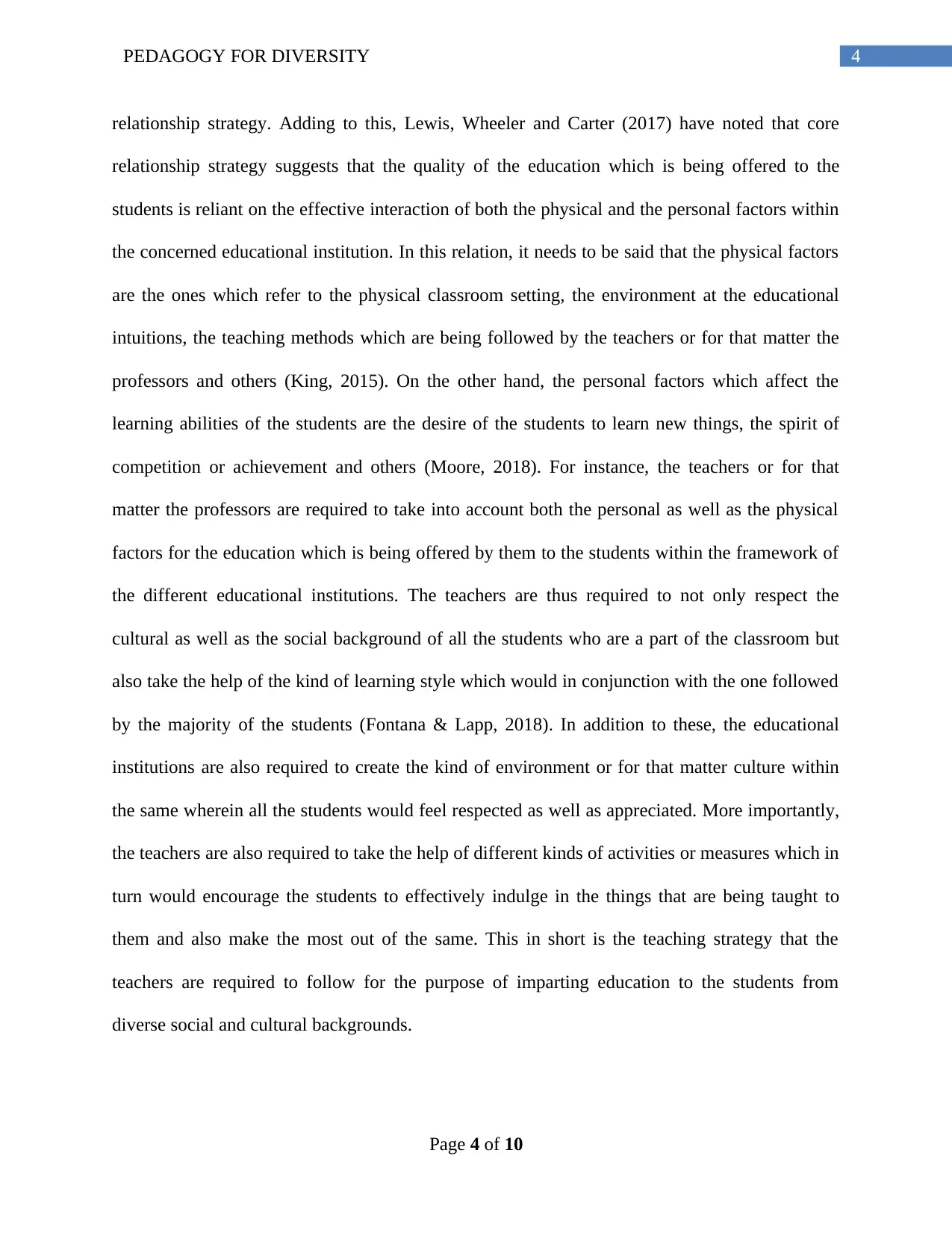
4PEDAGOGY FOR DIVERSITY
relationship strategy. Adding to this, Lewis, Wheeler and Carter (2017) have noted that core
relationship strategy suggests that the quality of the education which is being offered to the
students is reliant on the effective interaction of both the physical and the personal factors within
the concerned educational institution. In this relation, it needs to be said that the physical factors
are the ones which refer to the physical classroom setting, the environment at the educational
intuitions, the teaching methods which are being followed by the teachers or for that matter the
professors and others (King, 2015). On the other hand, the personal factors which affect the
learning abilities of the students are the desire of the students to learn new things, the spirit of
competition or achievement and others (Moore, 2018). For instance, the teachers or for that
matter the professors are required to take into account both the personal as well as the physical
factors for the education which is being offered by them to the students within the framework of
the different educational institutions. The teachers are thus required to not only respect the
cultural as well as the social background of all the students who are a part of the classroom but
also take the help of the kind of learning style which would in conjunction with the one followed
by the majority of the students (Fontana & Lapp, 2018). In addition to these, the educational
institutions are also required to create the kind of environment or for that matter culture within
the same wherein all the students would feel respected as well as appreciated. More importantly,
the teachers are also required to take the help of different kinds of activities or measures which in
turn would encourage the students to effectively indulge in the things that are being taught to
them and also make the most out of the same. This in short is the teaching strategy that the
teachers are required to follow for the purpose of imparting education to the students from
diverse social and cultural backgrounds.
Page 4 of 10
relationship strategy. Adding to this, Lewis, Wheeler and Carter (2017) have noted that core
relationship strategy suggests that the quality of the education which is being offered to the
students is reliant on the effective interaction of both the physical and the personal factors within
the concerned educational institution. In this relation, it needs to be said that the physical factors
are the ones which refer to the physical classroom setting, the environment at the educational
intuitions, the teaching methods which are being followed by the teachers or for that matter the
professors and others (King, 2015). On the other hand, the personal factors which affect the
learning abilities of the students are the desire of the students to learn new things, the spirit of
competition or achievement and others (Moore, 2018). For instance, the teachers or for that
matter the professors are required to take into account both the personal as well as the physical
factors for the education which is being offered by them to the students within the framework of
the different educational institutions. The teachers are thus required to not only respect the
cultural as well as the social background of all the students who are a part of the classroom but
also take the help of the kind of learning style which would in conjunction with the one followed
by the majority of the students (Fontana & Lapp, 2018). In addition to these, the educational
institutions are also required to create the kind of environment or for that matter culture within
the same wherein all the students would feel respected as well as appreciated. More importantly,
the teachers are also required to take the help of different kinds of activities or measures which in
turn would encourage the students to effectively indulge in the things that are being taught to
them and also make the most out of the same. This in short is the teaching strategy that the
teachers are required to follow for the purpose of imparting education to the students from
diverse social and cultural backgrounds.
Page 4 of 10
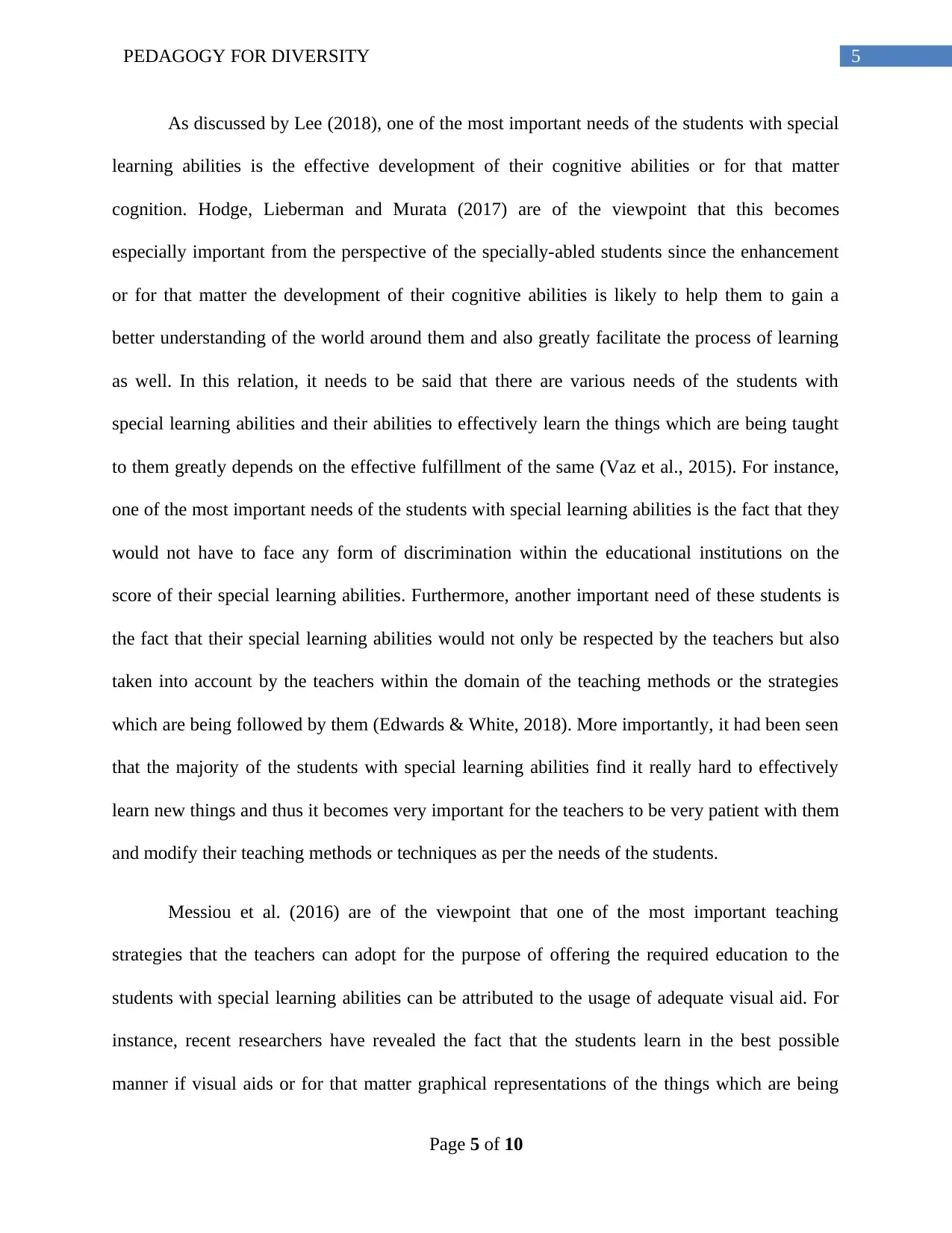
5PEDAGOGY FOR DIVERSITY
As discussed by Lee (2018), one of the most important needs of the students with special
learning abilities is the effective development of their cognitive abilities or for that matter
cognition. Hodge, Lieberman and Murata (2017) are of the viewpoint that this becomes
especially important from the perspective of the specially-abled students since the enhancement
or for that matter the development of their cognitive abilities is likely to help them to gain a
better understanding of the world around them and also greatly facilitate the process of learning
as well. In this relation, it needs to be said that there are various needs of the students with
special learning abilities and their abilities to effectively learn the things which are being taught
to them greatly depends on the effective fulfillment of the same (Vaz et al., 2015). For instance,
one of the most important needs of the students with special learning abilities is the fact that they
would not have to face any form of discrimination within the educational institutions on the
score of their special learning abilities. Furthermore, another important need of these students is
the fact that their special learning abilities would not only be respected by the teachers but also
taken into account by the teachers within the domain of the teaching methods or the strategies
which are being followed by them (Edwards & White, 2018). More importantly, it had been seen
that the majority of the students with special learning abilities find it really hard to effectively
learn new things and thus it becomes very important for the teachers to be very patient with them
and modify their teaching methods or techniques as per the needs of the students.
Messiou et al. (2016) are of the viewpoint that one of the most important teaching
strategies that the teachers can adopt for the purpose of offering the required education to the
students with special learning abilities can be attributed to the usage of adequate visual aid. For
instance, recent researchers have revealed the fact that the students learn in the best possible
manner if visual aids or for that matter graphical representations of the things which are being
Page 5 of 10
As discussed by Lee (2018), one of the most important needs of the students with special
learning abilities is the effective development of their cognitive abilities or for that matter
cognition. Hodge, Lieberman and Murata (2017) are of the viewpoint that this becomes
especially important from the perspective of the specially-abled students since the enhancement
or for that matter the development of their cognitive abilities is likely to help them to gain a
better understanding of the world around them and also greatly facilitate the process of learning
as well. In this relation, it needs to be said that there are various needs of the students with
special learning abilities and their abilities to effectively learn the things which are being taught
to them greatly depends on the effective fulfillment of the same (Vaz et al., 2015). For instance,
one of the most important needs of the students with special learning abilities is the fact that they
would not have to face any form of discrimination within the educational institutions on the
score of their special learning abilities. Furthermore, another important need of these students is
the fact that their special learning abilities would not only be respected by the teachers but also
taken into account by the teachers within the domain of the teaching methods or the strategies
which are being followed by them (Edwards & White, 2018). More importantly, it had been seen
that the majority of the students with special learning abilities find it really hard to effectively
learn new things and thus it becomes very important for the teachers to be very patient with them
and modify their teaching methods or techniques as per the needs of the students.
Messiou et al. (2016) are of the viewpoint that one of the most important teaching
strategies that the teachers can adopt for the purpose of offering the required education to the
students with special learning abilities can be attributed to the usage of adequate visual aid. For
instance, recent researchers have revealed the fact that the students learn in the best possible
manner if visual aids or for that matter graphical representations of the things which are being
Page 5 of 10
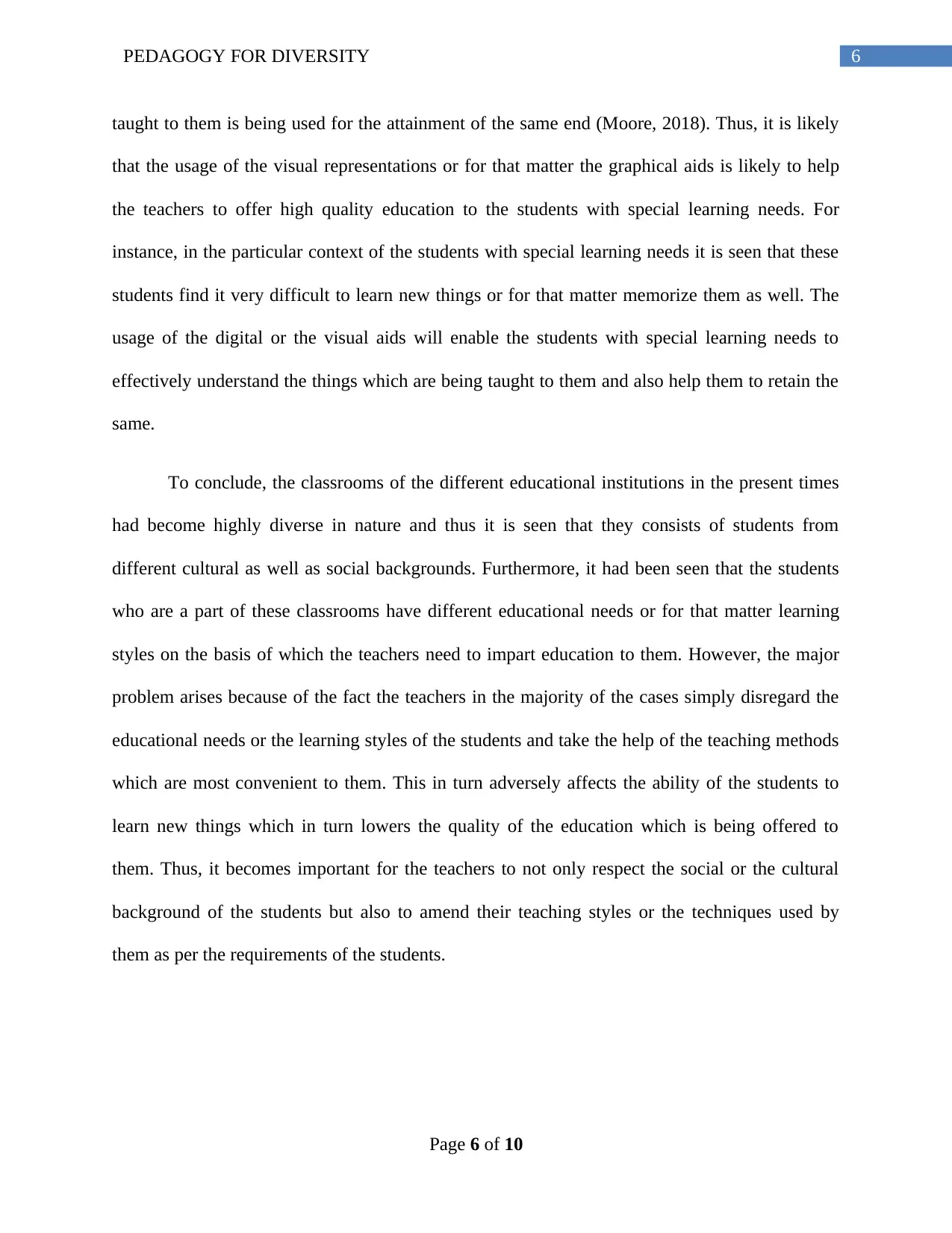
6PEDAGOGY FOR DIVERSITY
taught to them is being used for the attainment of the same end (Moore, 2018). Thus, it is likely
that the usage of the visual representations or for that matter the graphical aids is likely to help
the teachers to offer high quality education to the students with special learning needs. For
instance, in the particular context of the students with special learning needs it is seen that these
students find it very difficult to learn new things or for that matter memorize them as well. The
usage of the digital or the visual aids will enable the students with special learning needs to
effectively understand the things which are being taught to them and also help them to retain the
same.
To conclude, the classrooms of the different educational institutions in the present times
had become highly diverse in nature and thus it is seen that they consists of students from
different cultural as well as social backgrounds. Furthermore, it had been seen that the students
who are a part of these classrooms have different educational needs or for that matter learning
styles on the basis of which the teachers need to impart education to them. However, the major
problem arises because of the fact the teachers in the majority of the cases simply disregard the
educational needs or the learning styles of the students and take the help of the teaching methods
which are most convenient to them. This in turn adversely affects the ability of the students to
learn new things which in turn lowers the quality of the education which is being offered to
them. Thus, it becomes important for the teachers to not only respect the social or the cultural
background of the students but also to amend their teaching styles or the techniques used by
them as per the requirements of the students.
Page 6 of 10
taught to them is being used for the attainment of the same end (Moore, 2018). Thus, it is likely
that the usage of the visual representations or for that matter the graphical aids is likely to help
the teachers to offer high quality education to the students with special learning needs. For
instance, in the particular context of the students with special learning needs it is seen that these
students find it very difficult to learn new things or for that matter memorize them as well. The
usage of the digital or the visual aids will enable the students with special learning needs to
effectively understand the things which are being taught to them and also help them to retain the
same.
To conclude, the classrooms of the different educational institutions in the present times
had become highly diverse in nature and thus it is seen that they consists of students from
different cultural as well as social backgrounds. Furthermore, it had been seen that the students
who are a part of these classrooms have different educational needs or for that matter learning
styles on the basis of which the teachers need to impart education to them. However, the major
problem arises because of the fact the teachers in the majority of the cases simply disregard the
educational needs or the learning styles of the students and take the help of the teaching methods
which are most convenient to them. This in turn adversely affects the ability of the students to
learn new things which in turn lowers the quality of the education which is being offered to
them. Thus, it becomes important for the teachers to not only respect the social or the cultural
background of the students but also to amend their teaching styles or the techniques used by
them as per the requirements of the students.
Page 6 of 10
Paraphrase This Document
Need a fresh take? Get an instant paraphrase of this document with our AI Paraphraser
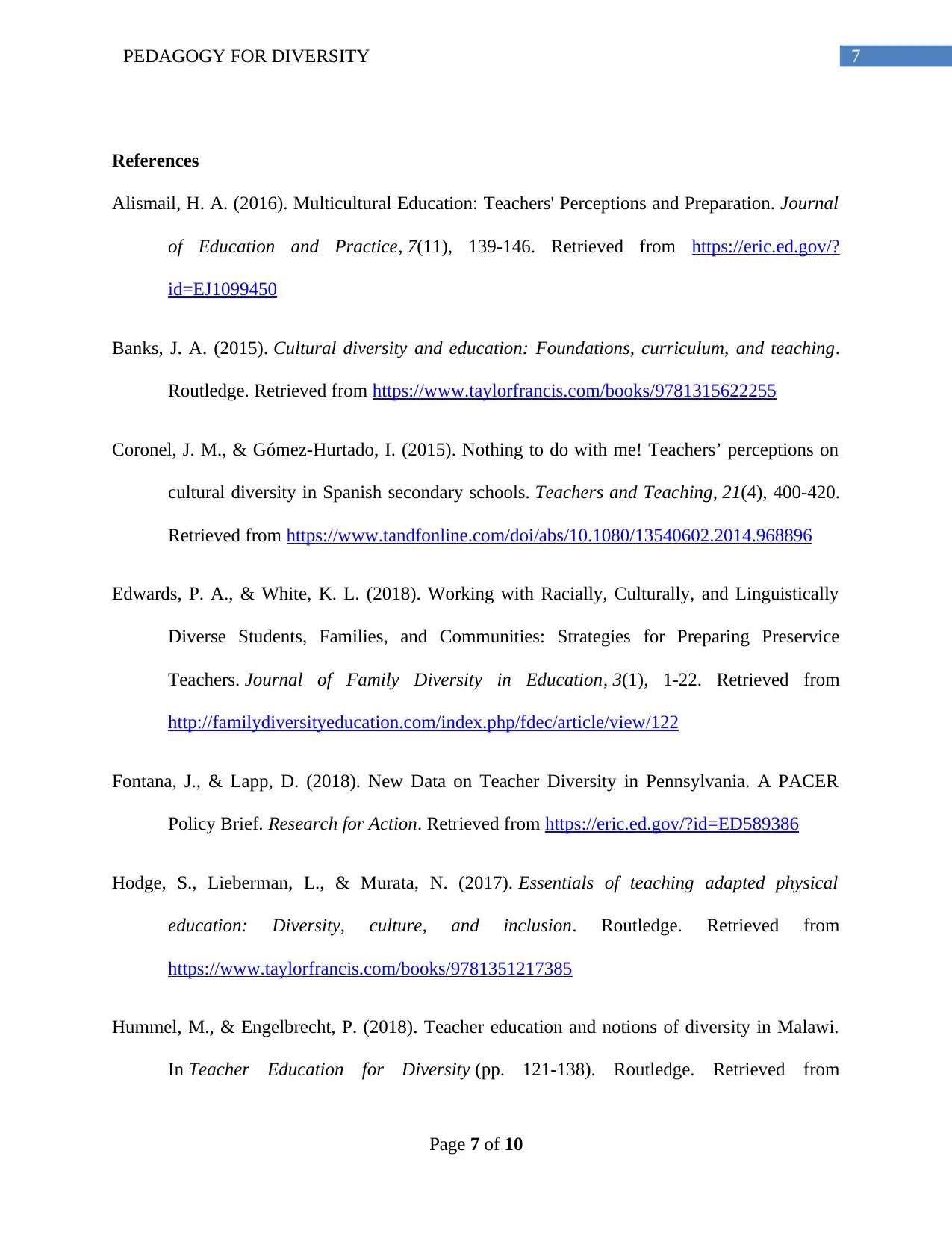
7PEDAGOGY FOR DIVERSITY
References
Alismail, H. A. (2016). Multicultural Education: Teachers' Perceptions and Preparation. Journal
of Education and Practice, 7(11), 139-146. Retrieved from https://eric.ed.gov/?
id=EJ1099450
Banks, J. A. (2015). Cultural diversity and education: Foundations, curriculum, and teaching.
Routledge. Retrieved from https://www.taylorfrancis.com/books/9781315622255
Coronel, J. M., & Gómez-Hurtado, I. (2015). Nothing to do with me! Teachers’ perceptions on
cultural diversity in Spanish secondary schools. Teachers and Teaching, 21(4), 400-420.
Retrieved from https://www.tandfonline.com/doi/abs/10.1080/13540602.2014.968896
Edwards, P. A., & White, K. L. (2018). Working with Racially, Culturally, and Linguistically
Diverse Students, Families, and Communities: Strategies for Preparing Preservice
Teachers. Journal of Family Diversity in Education, 3(1), 1-22. Retrieved from
http://familydiversityeducation.com/index.php/fdec/article/view/122
Fontana, J., & Lapp, D. (2018). New Data on Teacher Diversity in Pennsylvania. A PACER
Policy Brief. Research for Action. Retrieved from https://eric.ed.gov/?id=ED589386
Hodge, S., Lieberman, L., & Murata, N. (2017). Essentials of teaching adapted physical
education: Diversity, culture, and inclusion. Routledge. Retrieved from
https://www.taylorfrancis.com/books/9781351217385
Hummel, M., & Engelbrecht, P. (2018). Teacher education and notions of diversity in Malawi.
In Teacher Education for Diversity (pp. 121-138). Routledge. Retrieved from
Page 7 of 10
References
Alismail, H. A. (2016). Multicultural Education: Teachers' Perceptions and Preparation. Journal
of Education and Practice, 7(11), 139-146. Retrieved from https://eric.ed.gov/?
id=EJ1099450
Banks, J. A. (2015). Cultural diversity and education: Foundations, curriculum, and teaching.
Routledge. Retrieved from https://www.taylorfrancis.com/books/9781315622255
Coronel, J. M., & Gómez-Hurtado, I. (2015). Nothing to do with me! Teachers’ perceptions on
cultural diversity in Spanish secondary schools. Teachers and Teaching, 21(4), 400-420.
Retrieved from https://www.tandfonline.com/doi/abs/10.1080/13540602.2014.968896
Edwards, P. A., & White, K. L. (2018). Working with Racially, Culturally, and Linguistically
Diverse Students, Families, and Communities: Strategies for Preparing Preservice
Teachers. Journal of Family Diversity in Education, 3(1), 1-22. Retrieved from
http://familydiversityeducation.com/index.php/fdec/article/view/122
Fontana, J., & Lapp, D. (2018). New Data on Teacher Diversity in Pennsylvania. A PACER
Policy Brief. Research for Action. Retrieved from https://eric.ed.gov/?id=ED589386
Hodge, S., Lieberman, L., & Murata, N. (2017). Essentials of teaching adapted physical
education: Diversity, culture, and inclusion. Routledge. Retrieved from
https://www.taylorfrancis.com/books/9781351217385
Hummel, M., & Engelbrecht, P. (2018). Teacher education and notions of diversity in Malawi.
In Teacher Education for Diversity (pp. 121-138). Routledge. Retrieved from
Page 7 of 10
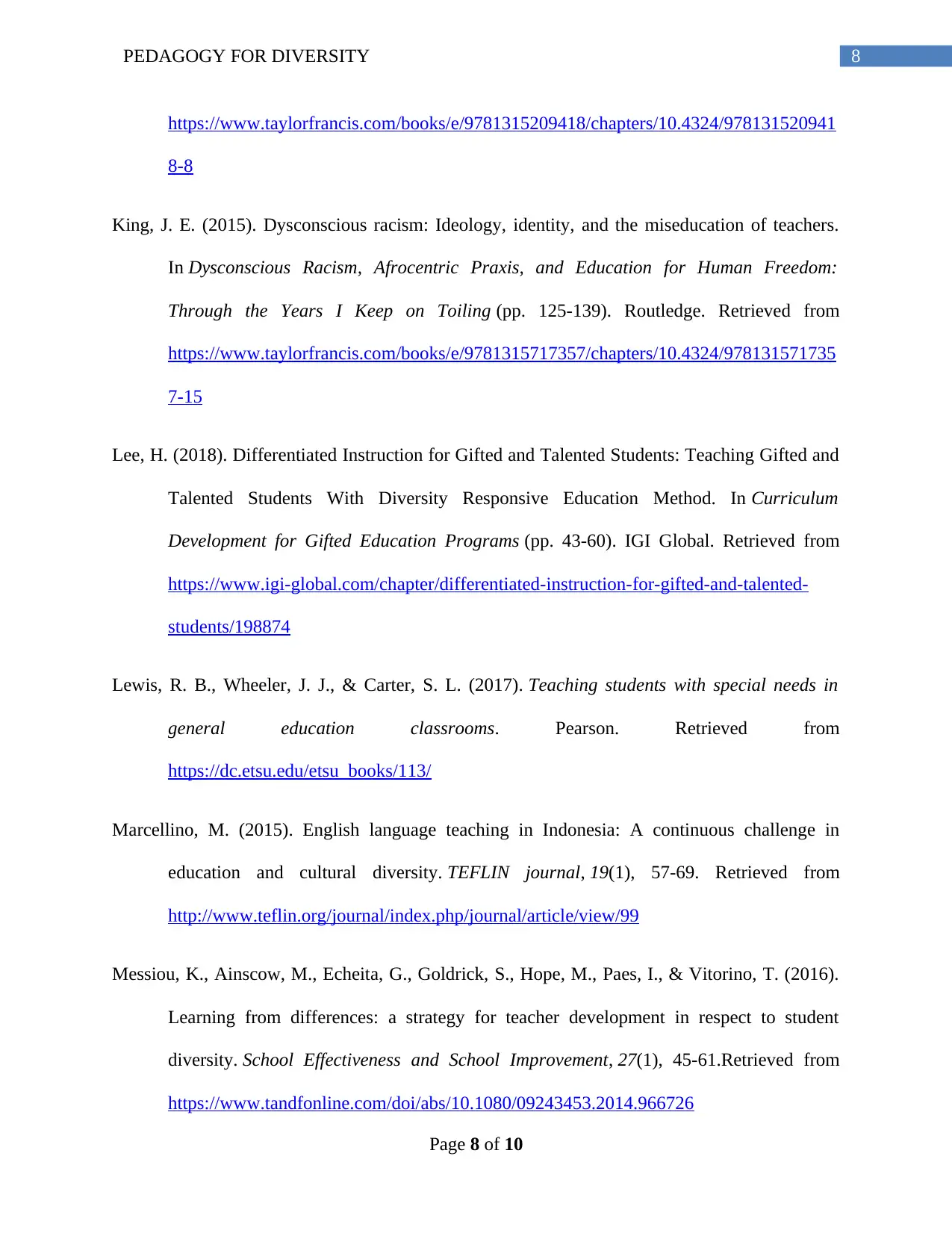
8PEDAGOGY FOR DIVERSITY
https://www.taylorfrancis.com/books/e/9781315209418/chapters/10.4324/978131520941
8-8
King, J. E. (2015). Dysconscious racism: Ideology, identity, and the miseducation of teachers.
In Dysconscious Racism, Afrocentric Praxis, and Education for Human Freedom:
Through the Years I Keep on Toiling (pp. 125-139). Routledge. Retrieved from
https://www.taylorfrancis.com/books/e/9781315717357/chapters/10.4324/978131571735
7-15
Lee, H. (2018). Differentiated Instruction for Gifted and Talented Students: Teaching Gifted and
Talented Students With Diversity Responsive Education Method. In Curriculum
Development for Gifted Education Programs (pp. 43-60). IGI Global. Retrieved from
https://www.igi-global.com/chapter/differentiated-instruction-for-gifted-and-talented-
students/198874
Lewis, R. B., Wheeler, J. J., & Carter, S. L. (2017). Teaching students with special needs in
general education classrooms. Pearson. Retrieved from
https://dc.etsu.edu/etsu_books/113/
Marcellino, M. (2015). English language teaching in Indonesia: A continuous challenge in
education and cultural diversity. TEFLIN journal, 19(1), 57-69. Retrieved from
http://www.teflin.org/journal/index.php/journal/article/view/99
Messiou, K., Ainscow, M., Echeita, G., Goldrick, S., Hope, M., Paes, I., & Vitorino, T. (2016).
Learning from differences: a strategy for teacher development in respect to student
diversity. School Effectiveness and School Improvement, 27(1), 45-61.Retrieved from
https://www.tandfonline.com/doi/abs/10.1080/09243453.2014.966726
Page 8 of 10
https://www.taylorfrancis.com/books/e/9781315209418/chapters/10.4324/978131520941
8-8
King, J. E. (2015). Dysconscious racism: Ideology, identity, and the miseducation of teachers.
In Dysconscious Racism, Afrocentric Praxis, and Education for Human Freedom:
Through the Years I Keep on Toiling (pp. 125-139). Routledge. Retrieved from
https://www.taylorfrancis.com/books/e/9781315717357/chapters/10.4324/978131571735
7-15
Lee, H. (2018). Differentiated Instruction for Gifted and Talented Students: Teaching Gifted and
Talented Students With Diversity Responsive Education Method. In Curriculum
Development for Gifted Education Programs (pp. 43-60). IGI Global. Retrieved from
https://www.igi-global.com/chapter/differentiated-instruction-for-gifted-and-talented-
students/198874
Lewis, R. B., Wheeler, J. J., & Carter, S. L. (2017). Teaching students with special needs in
general education classrooms. Pearson. Retrieved from
https://dc.etsu.edu/etsu_books/113/
Marcellino, M. (2015). English language teaching in Indonesia: A continuous challenge in
education and cultural diversity. TEFLIN journal, 19(1), 57-69. Retrieved from
http://www.teflin.org/journal/index.php/journal/article/view/99
Messiou, K., Ainscow, M., Echeita, G., Goldrick, S., Hope, M., Paes, I., & Vitorino, T. (2016).
Learning from differences: a strategy for teacher development in respect to student
diversity. School Effectiveness and School Improvement, 27(1), 45-61.Retrieved from
https://www.tandfonline.com/doi/abs/10.1080/09243453.2014.966726
Page 8 of 10
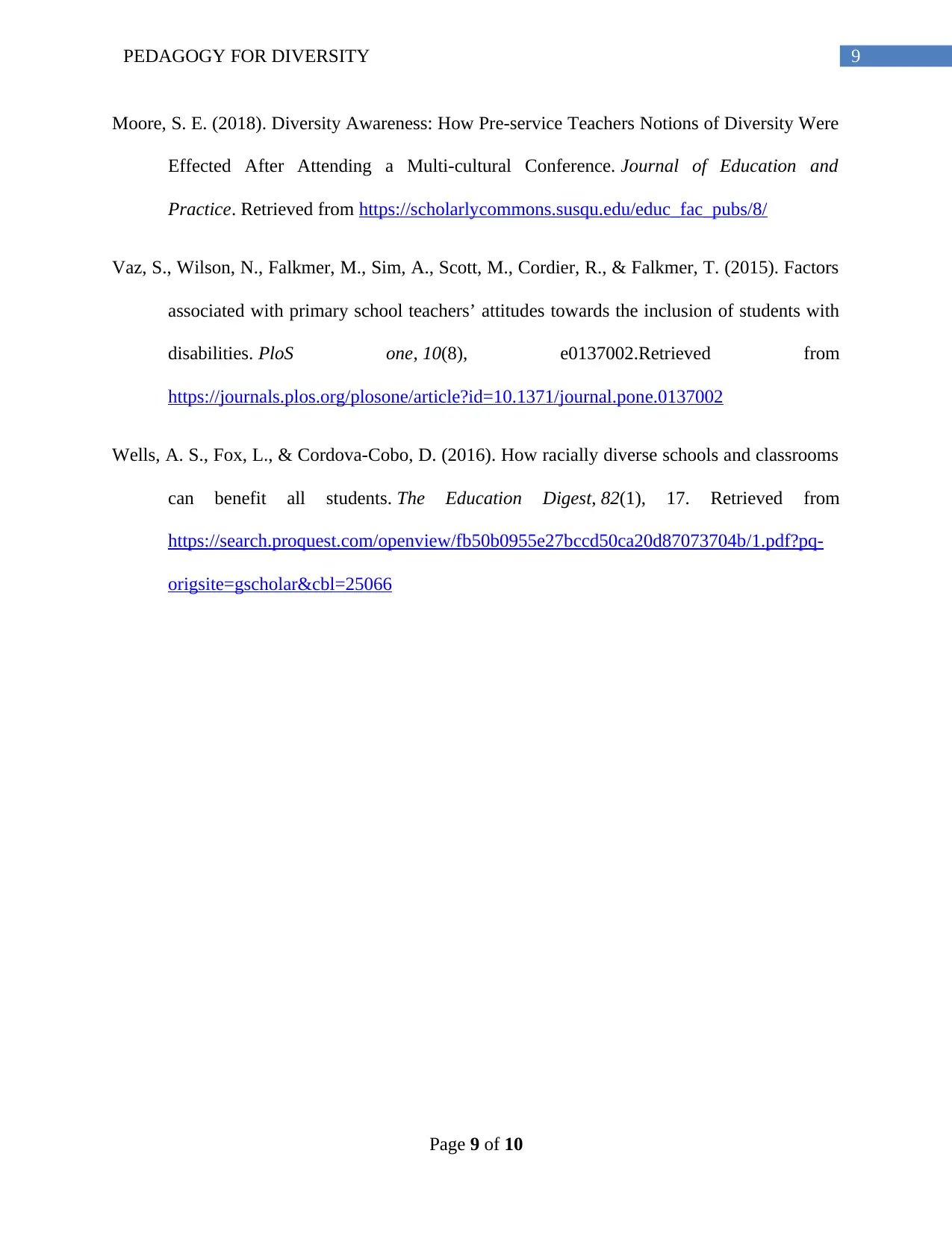
9PEDAGOGY FOR DIVERSITY
Moore, S. E. (2018). Diversity Awareness: How Pre-service Teachers Notions of Diversity Were
Effected After Attending a Multi-cultural Conference. Journal of Education and
Practice. Retrieved from https://scholarlycommons.susqu.edu/educ_fac_pubs/8/
Vaz, S., Wilson, N., Falkmer, M., Sim, A., Scott, M., Cordier, R., & Falkmer, T. (2015). Factors
associated with primary school teachers’ attitudes towards the inclusion of students with
disabilities. PloS one, 10(8), e0137002.Retrieved from
https://journals.plos.org/plosone/article?id=10.1371/journal.pone.0137002
Wells, A. S., Fox, L., & Cordova-Cobo, D. (2016). How racially diverse schools and classrooms
can benefit all students. The Education Digest, 82(1), 17. Retrieved from
https://search.proquest.com/openview/fb50b0955e27bccd50ca20d87073704b/1.pdf?pq-
origsite=gscholar&cbl=25066
Page 9 of 10
Moore, S. E. (2018). Diversity Awareness: How Pre-service Teachers Notions of Diversity Were
Effected After Attending a Multi-cultural Conference. Journal of Education and
Practice. Retrieved from https://scholarlycommons.susqu.edu/educ_fac_pubs/8/
Vaz, S., Wilson, N., Falkmer, M., Sim, A., Scott, M., Cordier, R., & Falkmer, T. (2015). Factors
associated with primary school teachers’ attitudes towards the inclusion of students with
disabilities. PloS one, 10(8), e0137002.Retrieved from
https://journals.plos.org/plosone/article?id=10.1371/journal.pone.0137002
Wells, A. S., Fox, L., & Cordova-Cobo, D. (2016). How racially diverse schools and classrooms
can benefit all students. The Education Digest, 82(1), 17. Retrieved from
https://search.proquest.com/openview/fb50b0955e27bccd50ca20d87073704b/1.pdf?pq-
origsite=gscholar&cbl=25066
Page 9 of 10
1 out of 10
Related Documents
Your All-in-One AI-Powered Toolkit for Academic Success.
+13062052269
info@desklib.com
Available 24*7 on WhatsApp / Email
![[object Object]](/_next/static/media/star-bottom.7253800d.svg)
Unlock your academic potential
© 2024 | Zucol Services PVT LTD | All rights reserved.





